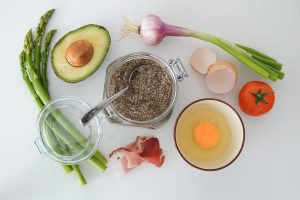Spanish Level 2- Face-to-Face Activities
🍉 Spanish Level 2, Activity 06: Mis ingredientes y comidas favoritas / My Favorite Ingredients and Foods (Face-to-Face)

Practices: Shopping for food, going out to eat
Perspectives: What makes an ingredient popular or unpopular?
NCSSFL-ACTFL World-Readiness Standards:
- Standard 1.1 Students engage in conversations, provide and obtain information, express feelings and emotions, and exchange opinions.
- Standard 1.2 Students understand and interpret spoken and written Spanish on a variety of topics.
- Standard 1.3 Students present information, concepts, and ideas in Spanish to an audience of listeners or readers on a variety of topics.
Idaho State Content Standards:
- COMM 1.1 – Interact and negotiate meaning (spoken, signed, written conversation) to share information, reactions, feelings, and opinions
- COMM 2.1 – Understand, interpret, and analyze what is heard, read, or viewed on a variety of topics.
- COMM 3.1 – Present information, concepts, and ideas to inform, explain, persuade, and narrate on a variety of topics using appropriate media in the target language.
NCSSFL-ACTFL Can-Do Statements:
- I can describe popular foods without using buzzwords
- I can compare and contrast my food preferences with friends
- I can discuss how frequently I eat or visit a restaurant
Materials Needed:
- Vis-A-Vis Markers (erasable whiteboard markers) & Erasers
- Survey Cards
- Google Slideshow
Optional Physical Materials
- Taboo Cards
Would you like to make changes to the materials? Access the template(s) below:
- Taboo Cards (Canva Template, free account required)
- Survey Cards (Canva template, free account required)
Need help with customizing the templates? View this video for help.
Warm-Up
- Begin by opening the Google Slideshow and introducing the Can-Do Statements.
Hola, ¿cómo están? Estoy ____. Vamos a empezar el lab de hoy con los can-do statements.
- Have students scan the QR code or give a student a Taboo Card if using physical materials. The student has to describe the food on the card to the group, without saying the words on the card.
Hoy vamos a jugar un juego. El estudiante tiene que describir la comida que está en la tarjeta, pero no puede decir las palabras que están escritas ahí. - The whole group has to guess the item the student is describing. If they guess it, then they get a point!
El grupo tiene que adivinar (guess) la comida que el estudiante está describiendo. La persona que adivina la comida gana un punto!
Main Activity
- Give each student a Survey Card, a marker, and an eraser. Give them a minute to read the card.
Les voy a dar una tarjeta de encuesta. Cada tarjeta es diferente. Tomen un minuto para leerla. - Have the students fill in the empty categories on their lists.
Ahora llenen los espacios vacíos. Por ejemplo, si el espacio vacío dice fruta, deben escribir banana o manzana u otra fruta. Pero no usen una comida que ya está. - One student will ask their partner questions to find out about their likes/dislikes in an interview style, and then they will switch.
Ahora van a hacer una entrevista con los compañeros del lab para conocer sus preferencias de la comida. Ejemplo: “¿Te gusta _ _ _ _ ? // Si, me gusta _ _ _ _ - Ask the following reflection questions
¿Cuál es una comida que a muchos estudiantes les gusta comer? ¿Cuál es una comida que a muchos estudiantes no les gusta comer?
Wrap-Up
- Ask students a few questions to finish the lab:
- ¿Te gusta la comida que puedes encontrar en Boise State? ¿Por qué? (Do you like the food you can find in Boise State? Why?)
- ¿Te molesta ir al supermercado? ¿Por qué? (Does it bother you to go to the supermarket? Why?)
- ¿Te gusta comer en un restaurante? ¿Por qué? (Do you like to eat in restaurants? Why?)
End of Activity:
• Read Can-Do statements once more and have students evaluate their confidence.
(Use thumbs up/thumbs down or download our student cards)
• Encourage students to be honest in their self-evaluation.
• Pay attention, and try to use feedback for future labs!
NCSSFL-ACTFL Can-Do Statements:
- I can describe popular foods without using buzzwords
- I can compare and contrast my food preferences with friends
- I can discuss how frequently I eat or visit a restaurant
CULTURAL NOTES:
- Top 10 ingredientes mexicanos – This article contains a list of the 10 most common ingredients in Mexican cuisine.
- ¿Cuáles son los ingredientes más comunes del mundo? – This article looks at over 40,000 recipes from around the world to find the most common ingredients in cooking. It is probably no surprise that cebolla y ajo are the most popular!
- Las 10 comidas más ricas y populares del mundo– This article lists 10 of the most popular dishes around the world.
- This video titled “Ingredientes para una historia. La cocina mexicana” is a full length documentary in Spanish that looks at the most popular ingredients for Mexican cooking such as corn, beans, avocados, tomatillos, and many more.
How to Revise or Remix a Pathways Project Activity
Feeling creative? The Pathways Project needs your help in revising and remixing activities for the K-16 language classroom.
Try taking an activity to the next level by:
- Add new content (something you’ve created or another OER source)
- Contribute additional activity suggestions
- Integrate authentic materials such as videos, infographics, photos, etc.
- Suggest how to implement the activity in the classroom
- Customize the content for a specific audience or group of learners (for example, K-5 learners or to differentiate for student’s needs)

